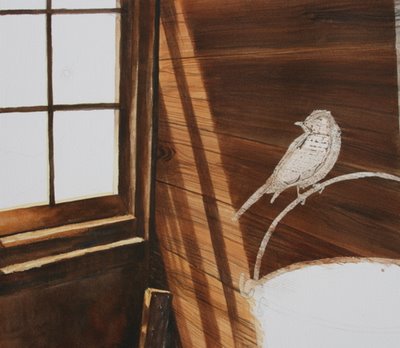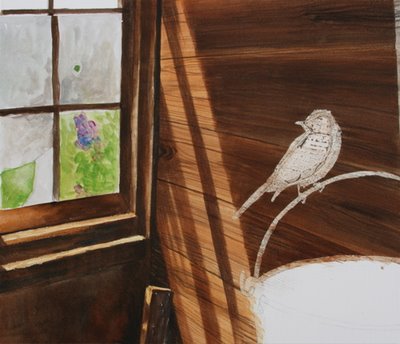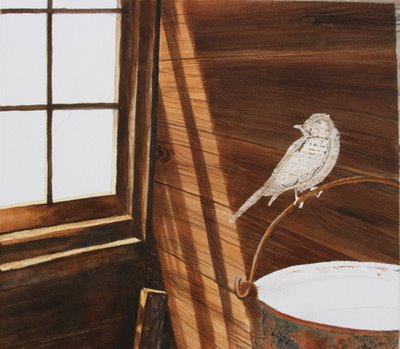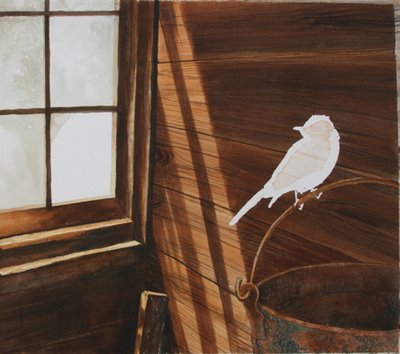Painting a Phoebe, Part 2

I've mentioned the concept as being paramount in making a painting. Maybe it's the illustrator in me. I've been illustrating since 1976, and I can't help but tell some kind of story with my paintings. So I had this concept of a phoebe in a barn that just had to get out. As I worked on the painting, it became clear that there would have to be some way for the phoebe to get in and out of the barn in which it was perched. How to do that? Break a pane out of the window, of course.
It was a little alarming that I hadn't considered that before, but my mind was all filled up with windowpanes and sunbeams, and I hadn't had time to think about how the phoebe might have gotten inside the barn in the first place. And obviously, he'd need a way out, too. So I decided to knock a windowpane out. But which pane?
This is where watercolor can be a challenge. You have to know exactly what you're doing. You have to plan. You can't really paint an intact window in transparent watercolor and then decide to go and break a pane out of it. So I took another piece of paper, painted some sample panes and broken places on it, and taped it to the painting. This way, I could try out some ideas before committing them to paint.
 Two panes (plus a bullethole) seemed like overkill. It would look better with just one pane out. The lower right pane seemed the best choice, compositionally.
Two panes (plus a bullethole) seemed like overkill. It would look better with just one pane out. The lower right pane seemed the best choice, compositionally.As I looked out my studio window, I could see my favorite lilac, about to bloom. What heaven, to look out and see that. I decided that the glimpse of the outside world would be my heirloom lilac, bathed in sun, blooming its head off. I painted a little panel on a scrap of watercolor paper and taped it to the painting. Good. I like that. I painted the study on a day when it was in the upper 70's. By the next day, it had dropped to 22 degrees, and it's clear to me now that my heirloom lilac will not be blooming this year at all. I am sick about it, but there's nothing you can do about a crispy, wilted, translucent lilac. You just have to suck it up and hope the thing lives another year, having had its entire first flush of leaves and blossoms frozen smack off. April. Pah.
The copper bucket was next. Apologizing to the Carolina wrens, I got a stepladder out and lowered the ancient holey bucket they nest in under the eaves. I put it up there for them four years ago, and they've nested in it ever since. I carefully removed their nesting material-not yet renewed for the season-and dumped out the dust, feather sheaths and blowflies that had accumulated over the years. Took the bucket inside and painted it. An hour later, while I was still working on the bucket, I went outside to photograph the painting and a pair of Carolina wrens scolded and sang and made it very clear that I was to replace the bucket the moment I was done with it. Message received.
 You can see that, having made my decision about the windowpane, I've removed the sample panel and left the window blank again. Time to focus on the copper bucket.
You can see that, having made my decision about the windowpane, I've removed the sample panel and left the window blank again. Time to focus on the copper bucket.Here, on the bucket, salt was my friend. I wanted a scrofulous finish, with Paris green and rust and oxidation creeping over it. I doused the surface with strong pools of dark pigment, then sprinkled table salt onto it. The salt would attract the water, and leave little pools of pigment wherever it had settled. Kosher salt would make larger sparkles, having larger grain. I used both. The bucket was a snap to paint, after I peeled off the masking compound.

I've peeled off the phoebe's masking compound too. Believe it or not, this is just the end of the second day. I told you a lot happened that second day. I've got the wood pretty much under control, the bucket painted, and the windowpanes started. I like the way the light is coming in. It's believable. Believable light is the single hardest thing to do in any painting, as far as I'm concerned. You have to exaggerate it so much to get it across at all...I'm saving the phoebe for dessert. I've also got a job ahead of me in ageing the wood behind the phoebe. Right now, it looks like fresh-milled cedar, and I want it to look like old, old pine. The stuff of much thought, consideration, and many overwashes. At least the light is happening. To be continued...
Labels: light in painting, phoebes, Watercolor painting






<< Home